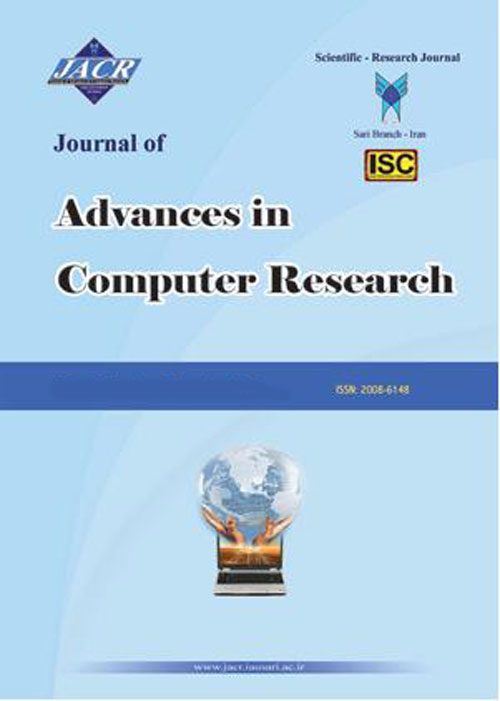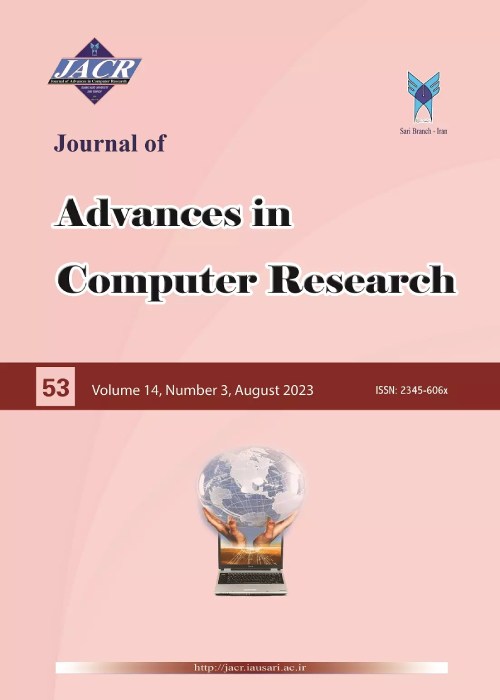فهرست مطالب

Journal of Advances in Computer Research
Volume:10 Issue: 1, Winter 2019
- تاریخ انتشار: 1397/11/12
- تعداد عناوین: 8
-
Pages 1-10
Nowdays, energy consumption as a critical issue in distributed computing systems with high performance has become so green computing tries to energy consumption, carbon footprint and CO2 emissions in high performance computing systems (HPCs) such as clusters, Grid and Cloud that a large number of parallel. Reducing energy consumption for high end computing can bring various benefits such as reducing costs, increasing system reliability & availability, and environmental respect. This paper aims to develop scheduling heuristics and to present application experience for reducing power consumption of parallel tasks in a cloud data center with the Dynamic Voltage Frequency Scaling (DVFS) technique and task duplication. In this paper, formal models are presented for precedence-constrained parallel tasks, DVFS-enabled processors, and energy consumption. In this paper, we develop a new scheduling algorithm called Energy Aware Scheduling Algorithm based on DVFS technique and task duplication strategy, called EADUPDVFS. Models and scheduling heuristics are examined with a simulation study. Using simulations we show our algorithm not only maintains good performance, but also has a good improvement on energy efficiency for parallel applications.
Keywords: cloud computing, dynamic voltage frequency scaling (DVFS), Task duplication, makespan -
Pages 11-24Image segmentation is one of the most common steps in digital image processing. The area many image segmentation algorithms (e.g., thresholding, edge detection, and region growing) employed for classifying a digital image into different segments. In this connection, finding a suitable algorithm for medical image segmentation is a challenging task due to mainly the noise, low contrast, and steep light variations of medical images. Due to the inherently parallel nature of image segmentation algorithms, they suit well for implementation on a Graphics Processing Unit (GPU). The main goal of this paper is to improve the performance of fuzzy c-means clustering through the parallel implementation of this algorithm. Although fuzzy c-means clustering is an important iterative clustering algorithm, it is computationally intensive and uses the same data between the iterations. The center of the clusters changes in each iteration, which requires a considerable amount of time for large data sets. The parallel fuzzy c-means clustering is implemented by applying pipeline parallelism on GPU. The experimental results show that the performance is improved up to 23.35x. Next, the watershed algorithm is applied to the final segmentation. In this paper using parallel fuzzy c-means clustering and computations we have attained competing results with other papers. The implementation results on the BRATS2015 show that the accuracy of diagnosis in Dice Similarity Coefficient metric 97/33% is obtained. This improvement is achieved using enhancing edges and reducing noises in images.Keywords: Parallel Fuzzy C-Means Clustering, Watershed Algorithm, FCM, CUDA, GPU
-
Pages 25-42One of transient phenomenon that causes the mal-operation of the power transformer differential protection during the energization of a loaded power transformer is the ultra-saturation phenomenon. In this paper, a new model for investigating the ultra-saturation phenomenon during the energization of a loaded power transformer is presented and its effect on the differential protection of the power transformer is considered. In this model, the nonlinear characteristic of the power transformer core, the effect of current transformers, and the core losses of the power transformer are taken into account. It is assumed that the load of the power transformer is a resistive and inductive load. Also, the effect of the residual flux and inception angle on the ultra-saturation phenomenon are investigated. In this paper, simulation is done by MATLAB software. The differential protection of the power transformer must be accurate and fast, so the description of the ultra-saturation phenomena is the first level for preventing of the mal-operation of the differential protection. The outcomes of this research can further be used as hints for substation operation personnel as well as for the development of new protection stabilization criteria, which is not discussed further in this paper.Keywords: power transformer, differential protection, Inrush current, ultra-saturation phenomenon, false trip
-
Pages 43-58
In the last few decades, technological progress has been made important information systems that require high security, Use safe and efficient methods for protecting their privacy. It is a major challenge to Protecting vital data and the ability to threaten attackers. And this has made it important and necessary to be sensitive to the authentication and identify of individuals in confidential network systems. In this paper, a method is presented for protecting privacy in social networks with a hybrid biometric architecture. In the proposed method, was used to the combination of biometric indexes of fingerprints and iris effect to maintain confidentiality in user access and authentication. Also, to demonstrate the availability of the method, an accurate evaluation is made by creating a model that is implemented with the help of integrated modeling language and colored petri nets with strong mathematical backing. The results indicate improved access and privacy with high confidentiality
Keywords: Authenticated, Availability, Biometric component, Colored petri nets, Integrated modeling language -
Pages 59-72
For the first time, the 4- and 5-port optical routers are designed by using the West First routing algorithm for use in optical network on chip. The use of the WF algorithm has made the designed routers to provide non-blocking routing in photonic network on chip. These routers not only are based on high speed Mach-Zehnder switches(Which have a higher bandwidth and more thermal tolerance than microring resonator switches), but also are more flexible than the XY algorithm based routers. these routers are capable of routing with the speed of 20 Gb/s. In the design of the routers, the least number of switching elements and waveguide crossings has improved the optical network on chip evaluation parameters. The results of the simulation show that all of the evaluation parameters such as: insertion loss, bit error ratio(BER), power budget, quality factor and eye diagrams are in an acceptable range, and the proposed routers are appropriate for use in optical network on chip.
Keywords: Mach-Zehnder interferometer, optical router, photonic network on chip, West First routing algorithm -
Pages 73-88
three dimensional- high efficiency video coding (3D-HEVC) is the expanded version of the latest video compression standard, namely high efficiency video coding (HEVC), which is used to compress 3D videos. 3D videos include texture video and depth map. Since the statistical characteristics of depth maps are different from those of texture videos, new tools have been added to the HEVC standard for intra coding. Thirty-five intra prediction modes with the recursive block partitioning structure in HEVC and the depth modeling modes improve the intra coding efficiency while increase the computational complexity. This Standard achieves the highest possible coding efficiency compared with predecessor standards, while increases the computational complexity that makes the 3D-HEVC cannot be suitable for real-time applications. In this paper, a fast intra prediction mode decision method is proposed to code depth map for 3D videos. Since the texture of video and the corresponding depth map represent the same scene, there is a high correlation between the prediction mode of texture video and its depth map. Thus, we can skip some depth map intra prediction modes rarely used in the related texture coding unit. The simulation results show that the proposed method reduces computational complexity by 23.66% compared to 3D-HEVC standard with an increase of 0.09% bit rate
Keywords: video compression, intra-prediction, depth-map -
Pages 89-96
Quantum-dot Cellular Automata (QCA) technology is attractive due to its low power consumption, fast speed and small dimension, therefore, it is a promising alternative to CMOS technology. In QCA, configuration of charges plays the role which is played by current in CMOS. This replacement provides the significant advantages. Additionally, exclusive-or (XOR) gate is a useful building block in many important circuits such as full adder (FA). In this paper we propose a novel design for two-input XOR gate in QCA. Two-input XORs could be utilized in constructing three-input ones which are widely used. The proposed XOR gate is the smallest design among the two-input XORs and it achieves significant improvements in terms of complexity and latency in comparison to the only existing similarly designed gate. Contrary to the common designing method which uses the logic function of XOR, the gate is constructed based on explicit interactions between QCA cells. The simulation results have been verified using the QCADesigner.
Keywords: Quantum-Dot Cellular Automata (QCA), Nanotechnology, Circuit Design, XOR gate, Circuit Simulation -
Pages 97-110
Impulsive noise is one of the imposed defectives degrades the quality of images. Performance of many image processing applications directly depends on the quality of the input image. Hence, it is necessary to de-noise the degraded images without losing their valuable information such as edges. In this paper we propose a method to remove impulsive noise from color images without damaging the image details. The proposed method employs the bit planes information of the image in various color channels to recover the noise corrupted pixels. Experimental results show capability of the proposed method in preserving image details compared to the classic median filter de-noising and the weighted couple sparse representation based methods.
Keywords: impulsive noise, Salt, Pepper noise, bit planes, de-noising, median filter


